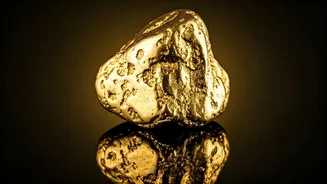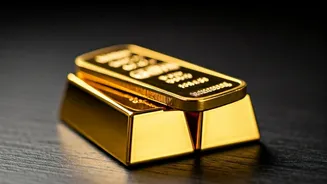Rarer Than Diamonds
Gold's scarcity contributes to its high value, making it more exceptional than you might realize. The fact that it is rarer than diamonds might be surprising
to many. The process of mining and extracting gold is complex and often yields small quantities, which further underscores its rarity. This scarcity, combined with its unique properties, like resistance to corrosion and its role in electronics, ensures that gold continues to be sought after and highly valued globally. This precious metal’s inherent worth is deeply rooted in both its limited availability and its versatile utility in various industries.
Incredibly Stretchy Gold
One of the most remarkable properties of gold is its incredible ductility. Imagine stretching one ounce of gold into a wire that's about 80 kilometers long. Such ductility speaks to gold's atomic structure and the way its atoms can slide past each other without breaking the metal's bonds. This malleability is also why gold is so easily crafted into intricate jewelry or used in delicate electronic components. The ability to manipulate gold into incredibly thin wires or sheets makes it ideal for many technological applications where precision and conductivity are crucial.
Gold in Your Phone
Did you know that your phone, a device you likely use daily, contains gold? This precious metal plays a crucial role in the circuitry and connections within smartphones and other electronic devices. Gold’s excellent conductivity, resistance to corrosion, and its ability to maintain reliable contact even in small quantities make it an ideal material for these applications. The tiny amounts of gold used in each phone may seem insignificant, but when multiplied by the billions of devices manufactured worldwide, it significantly impacts the demand for this precious metal. It highlights gold's essential role in modern technology.
Stretching to Room Size
The remarkable ductility of gold also allows it to be stretched significantly. One ounce of gold can be stretched into a wire that could potentially cover the surface of a bedroom, emphasizing its malleability. This ability to be manipulated into thin sheets or wires is what makes gold such a versatile material for various applications, from electronics to decorative items. The ability to create large surface areas from a small amount of gold showcases its unique physical properties. It helps to understand the engineering challenges of working with this precious metal.
China's Gold Dominance
China leads the world in gold production, which demonstrates its significant influence in the global gold market. The country's vast resources and advanced mining technologies have enabled it to extract large quantities of gold. This position gives China considerable sway over gold prices and supply, influencing the market. China's dominant position is a crucial factor in the gold market, and its production levels are closely watched by investors, traders, and policymakers worldwide, reflecting its essential role in the economic landscape.
Pure Gold Softness
Pure gold is remarkably soft, a characteristic that contrasts with the popular image of it being a hard, unyielding metal. This softness makes it relatively easy to shape and mold, which is advantageous for jewelry making and other artistic applications. However, this also means that pure gold is not ideal for everyday use, especially in items like jewelry. This is why gold is often alloyed with other metals to increase its strength and durability. Pure gold's softness is a key factor in how it is used and handled, influencing both its aesthetic appeal and its practical applications.
Almost Indestructible Nature
Gold's resistance to corrosion and its inert nature make it nearly indestructible. Unlike many other metals, gold does not rust or tarnish when exposed to air or water. This stability is due to its atomic structure and its reluctance to react with other elements. This characteristic is why gold artifacts have survived for thousands of years, preserving their beauty and value. Its durability contributes to its lasting value. Its resistance to degradation makes gold an ideal material for storing wealth and creating long-lasting objects.
Wrapping the World
The amount of gold mined throughout history is astonishing. Imagine that all the gold ever mined could be formed into a wire and wrapped around the Earth. The amount of gold available could circle the globe 11.2 million times. This astonishing figure demonstrates the sheer volume of gold that has been extracted and processed over centuries, reflecting its enduring value and the continuous demand for this precious metal. The number itself highlights both gold's abundance and its significance in human history.














